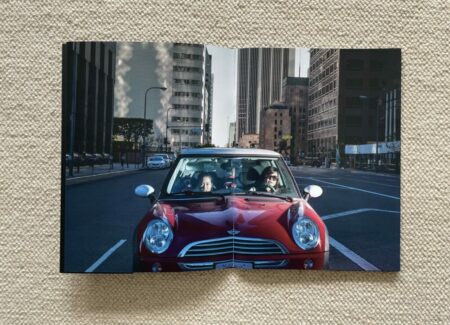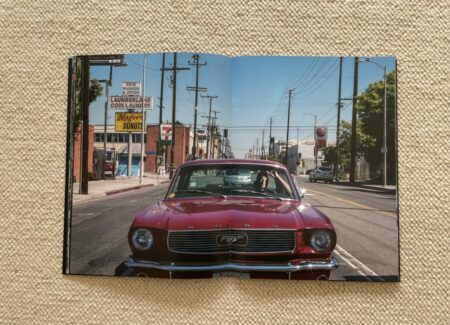JTF (just the facts): Published in 2022 by Skylark Editions (here). Softcover, with 24 color spreads. Includes an introductory essay by Dawoud Bey (on the inside cover flap.) Design by Bri Elliott. (Cover and spread shots below.)
Comments/Context: When scanning the tables at a photobook fair, often what I’m looking for is actually something I haven’t seen before. While every book is of course different and every artist has his or her own unique perspective, many photobook projects travel roads we’ve collectively been down many times previously, making their insights somewhat less revelatory or unexpected. So when a book comes along that shakes things up a bit or does something different, it tends to stand out.
Jonathan Castillo’s Car Culture is just such a photobook. Castillo’s book is filled with images of Los Angeles residents in their cars, and from that very short description, we wouldn’t necessarily assume we were in anything like new territory. Mike Mandel made images of people in their cars back in the 1970s; Chris Dorley-Brown did it again in London in the mid 1980s, followed by Andrew Bush in LA in the late 1980s; and Michael Spano tried out the same subject in New York somewhat more recently, and there are likely more names who can join this list. What’s different about Castillo’s photographs is that all of the other photographers generally took their images from the side (some at high speed), while Castillo has made his from directly in front, while in traffic.
How Castillo achieved this particular angle is worth understanding. If he had simply sat in the back of his car and shot out the back window, his subjects would have seen him at work, likely disrupting the process to some degree. So he mounted his camera and tripod in the back of his hatchback trunk so it could be triggered without being visible. His next problem was the light – images taken from that frontal angle would typically have a reflected, dark, or shadowed windshield, thereby obscuring the very people he wanted to photograph. His solution borrowed from Philip-Lorca diCorcia’s innovative across the sidewalk strobe used in his late 1990s series “Heads”; Castillo rigged up a flash in a companion car and used a radio-controlled trigger to synchronize the shutter and the strobe. The resulting artificial light briefly lit up the unsuspecting commuters, allowing him to get the images he wanted.
America’s car-centric culture is deservedly world renowned, and the Los Angeles version is its own particular variant, with its sprawling highways, low rise strip malls, wide boulevards, and neighborhoods designed to be traversed by car. And in just two dozen pictures, Castillo provides a quick tips-of-the-waves sampler of the Los Angeles vibe. The simplest place to start is a taxonomy of vehicles, which Castillo dutifully records, with their frontal grills and headlights like metallic faces. He gives us the conspicuous bling of the Rolls-Royce and more understated luxury of the Mercedes-Benz and Tesla; various smaller VW bugs, Fiats, and Mini Coopers; a range of practical Toyotas and Hondas; a few trucks and SUVs (one with a surfboard mounted on top); a selection of beaters with broken headlights and shiny muscle cars; and the more mundane service vehicles of a bus, a taxi, a U-Haul truck, and a mail van.
And while these cars themselves offer some glimpses of individual personality, the drivers, their passengers, and the various objects found on dashboards and hanging from rear view mirrors provide further clues to their lives. Castillo’s light invention gives the faces in the cars a surreal Hollywood spotlight effect, their now visible expressions, from intent hands-gripping-the-steering-wheel stress to far off lost-in-thought gazes, giving us a flavor for how the locals handle the traffic. The range of sunglass styles is particularly wide, and the woman with a car load of balloons is perhaps the most wonderful of Castillo’s random finds. The determined man with a dashboard cluttered with junk, including his thick copy of “The Living Lincoln”, a Hard Rock cafe hat, a white fedora, a feather, and a box of Ding Dongs in the passenger seat is another memorable character drawn from usually anonymous streets.
Compositionally, Castillo’s unconventional back-of-the-car vantage point also provides a view of the Los Angeles landscape that we haven’t seen much of before – from the middle of the street. Each image is centered on the car behind Castillo’s, so the roadside buildings and lines of perspective recede into the distance. In some places, the surroundings are downtown skyscrapers; in others, they are filled with leafy greenery or towering palm trees. In many other locations, the streetscape is densely packed with commercial buildings, including signage and billboards that shout from both sides of the traffic and telephone and electric poles that march down the neighborhood blocks. Seen as one flow, Car Culture actually provides more topographical information than we might have expected, filling out our understanding of how Los Angeles actually feels and functions.
For a fixed format, single subject photography project, Castillo’s Car Culture has a surprising amount of visual richness. In each image, there is the potential for drama and the clues to an imagined narrative, making each turn of the page an adventure. But hiding beneath that effervescent joy and easy approachability is a deeper sense of photographic structure, where the innovative approach to the picture making has opened up some new creative white space for Castillo to explore. Car Culture is memorable for its simplicity and its freshness, two artistic qualities that are far harder to achieve than we might like to admit.
Collector’s POV: Jonathan Castillo does not appear to have consistent gallery representation at this time. As a result, interested collectors should likely follow up directly with the artist via his website (linked in the sidebar).






















Wow. Instant classic.